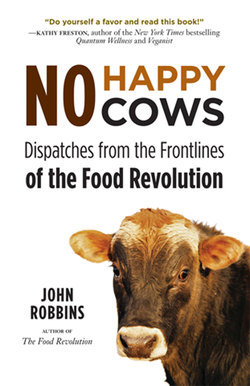Читать книгу No Happy Cows - John Robbins - Страница 13
На сайте Литреса книга снята с продажи.
Оглавление4
Health Food or Harm Food?The Truth about Soy
IN RECENT YEARS, I've received quite a number of requests from people asking for my views on soy products. Many of these inquiries have mentioned a stridently anti-soy article written by Sally Fallon and Mary G. Enig titled “Tragedy and Hype” that has been widely circulated. This article presents a systematic series of accusations against soy consumption, and has formed the basis for many similar articles. Many people, as a result, are now seriously questioning the safety of soy.
The litany of dangers of soy products, according to Fallon and Enig, is nearly endless. Tofu, they say, shrinks brains and causes Alzheimer's. Soy products promote rather than prevent cancer. Soy contains “anti-nutrients” and is full of toxins. The pro-soy publicity of the past few years is nothing but “propaganda.” Soy formula, they say, amounts to “birth control pills for babies.”
“Soy is not hemlock,” they conclude; “Soy is more insidious than hemlock.”
Fallon and Enig say the soy industry knows soy is poisonous, and “lie(s) to the public to sell more soy.” They say that soy is “the next asbestos.” They predict that there will be huge lawsuits with “thousands and thousands of legal briefs.” They warn that those who will be held legally responsible for deliberately manipulating the public to make money “include merchants, manufacturers, scientists, publicists, bureaucrats, former bond financiers, food writers, vitamin companies, and retail stores.”
Given the rapidly expanding role that soy in its many forms has come to play in the Western diet, these accusations are extremely serious. If they are true, the widespread trust that many people have come to have in soy is not only misplaced, but disastrous.
Soy foods have come to play such a significant role in the diets of many health-conscious people, and the allegations that have been made against them are so many and so grave, that I think the topic warrants a careful, detailed, and meticulous look. What follows is my attempt to provide an objective appraisal of both the benefits and the dangers of soy.
BLESSING OR CURSE?
Not that long ago, soybeans were considered by most Americans to be “hippie food.” But then medical research began accumulating that affirmed that soy consumption reduced heart disease and cancer risk, that it lengthened life and enhanced its quality, and that it provided an almost ideal protein substitute for animal proteins that almost inevitably come packaged with cholesterol and unhealthy forms of saturated fat. The mainstream culture began taking note. In a 1999 article titled “The Joy of Soy,” Time Magazine announced that consuming a mere 1.5 ounces of soy a day can significantly lower both total and LDL (“bad”) cholesterol levels. The evidence was becoming so convincing that even the ardently pro-pharmaceutical FDA wound up affirming that soybeans are a food that can prevent and even cure disease.
As the evidence of soy's health benefits accumulated, sales and consumption skyrocketed. Books like The Simple Soybean and Your Health, Tofu Cookery, and The Book of Tofu helped spread the word. Annual soy milk sales, which amounted to only a few million dollars in the early 1980s, have now soared to more than a billion dollars. And it's not just soy milk; it's all soy foods. From 1996 to 2011, annual soy food sales in the U.S. literally quintupled—increasing from $1 billion to $5 billion.
But, according to Fallon and Enig, this is all a tragic mistake, because soy is far indeed from living up to the many health claims that its proponents have made for it. Quite the contrary, they say: “[T]he soybean contains large quantities of natural toxins or ‘antinutrients,’ (including) potent enzyme inhibitors that block the action of trypsin and other enzymes needed for protein digestion…. They can produce serious distress, reduced protein digestion, and chronic deficiencies in amino acid uptake.”
